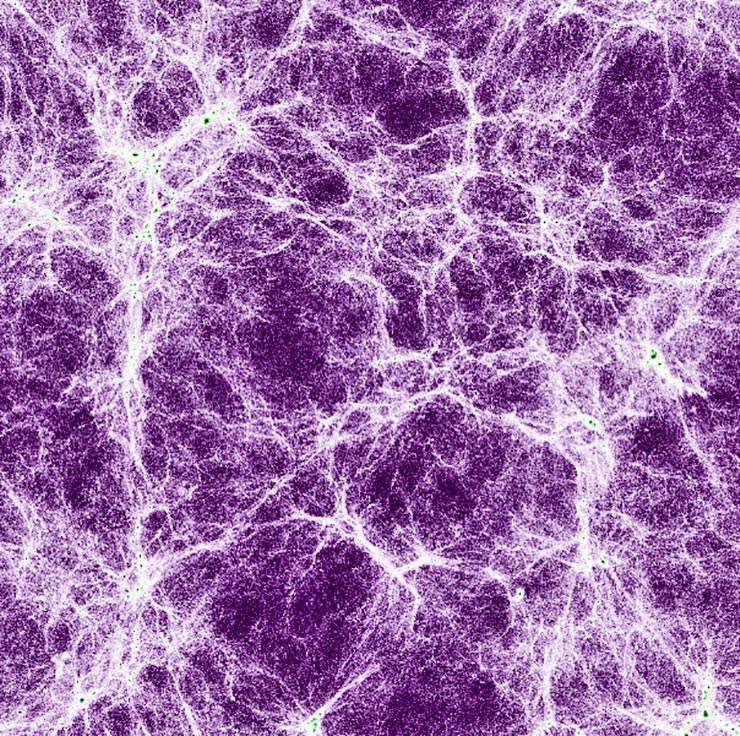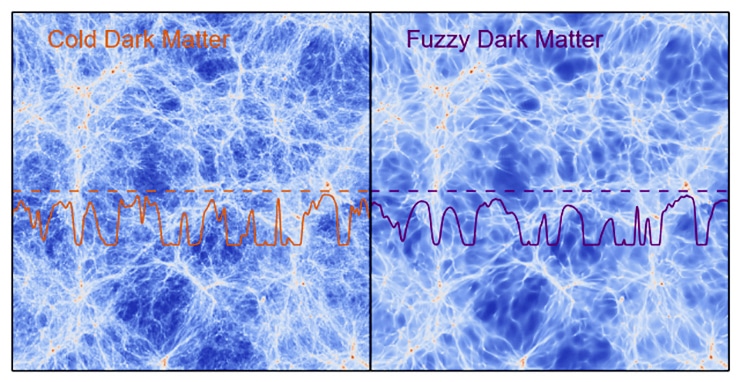New research on the nature of dark matter casts doubt on a relatively new theory called “fuzzy dark matter,” and instead lend credence to a different model called “cold dark matter.”
Dark matter is the aptly named unseen material that makes up the bulk of matter in our universe. But what it’s is made of is a matter of debate.
Scientists have never directly detected dark matter. But over decades, a variety of theories have been proposed about what material—from new particles to primordial black holes—could comprise it and explain its effects on normal matter.
For the new research, the findings of which appear in Physical Review Letters, cosmologists used data from the intergalactic medium—the vast, largely empty space between galaxies—to narrow down what dark matter could be.

The results could advance ongoing efforts to detect dark matter directly, especially if scientists have a clear idea of what sorts of properties they should be looking for.
Competing theories
“For decades, theoretical physicists have tried to understand the properties of the particles and forces that must make up dark matter,” says lead author Vid Iršič, a postdoctoral researcher in the astronomy department at the University of Washington.
“What we have done is place constraints on what dark matter could be—and ‘fuzzy dark matter,’ if it were to make up all of dark matter, is not consistent with our data.”
Scientists had drawn up both the “fuzzy” and “cold” theories to explain the effects that dark matter appears to have on galaxies and the intergalactic medium between them.
Cold dark matter is the older of these two theories, dating back to the 1980s, and is currently the standard model. It posits that dark matter is made up of a relatively massive, slow-moving type of particle with “weakly interacting” properties. It helps explain the unique, large-scale structure of the universe, such as why galaxies tend to cluster in larger groups.
But the cold dark matter theory also has some drawbacks and inconsistencies. For example, it predicts that our own Milky Way galaxy should have hundreds of satellite galaxies nearby. Instead, we have only a few dozen small, close neighbors.
The newer fuzzy dark matter theory addressed the deficiencies of the cold model. According to this theory, dark matter consists of an ultralight particle, rather than a heavy one, and also has a unique feature related to quantum mechanics.
For many of the fundamental particles in our universe, their large-scale movements—traveling distances of meters, miles, and beyond—can be explained using the principles of “classic” Newtonian physics. Explaining small-scale movements, such as at the subatomic level, requires the complex and often contradictory principles of quantum mechanics.
But for the ultralight particle predicted in the fuzzy theory, movements at incredibly large scales—such as from one end of a galaxy to the other—also require quantum mechanics.
Looking into the IGM
With these two theories in mind, scientists set out to model the hypothetical properties of dark matter based on relatively new observations of the intergalactic medium, or IGM.
The IGM consists largely of dark matter—whatever that may be—along with hydrogen gas and a small amount of helium. The hydrogen within IGM absorbs light emitted from distant, bright objects, and astronomers have studied this absorption for decades using Earth-based instruments.
Can fast radio bursts root out dark matter?
The team looked at how the IGM interacted with light emitted by quasars, which are distant, massive, starlike objects. One set of data came from a survey of 100 quasars by the European Southern Observatory in Chile. The team also included observations of 25 quasars by the Las Campanas Observatory in Chile and the W.M. Keck Observatory in Hawaii.
Using a supercomputer at the University of Cambridge, Iršič and colleagues simulated the IGM—and calculated what type of dark matter particle would be consistent with the quasar data.

They discovered that a typical particle predicted by the fuzzy dark matter theory is simply too light to account for the hydrogen absorption patterns in the IGM. A heavier particle—similar to predictions of the traditional cold dark matter theory—is more consistent with their simulations.
“The mass of this particle has to be larger than what people had originally expected, based on the fuzzy dark matter solutions for issues surrounding our galaxy and others,” Iršič says.
An ultralight “fuzzy” particle could still exist. But it can’t explain why galactic clusters form, or other questions like the paucity of satellite galaxies around the Milky Way. A heavier “cold” particle remains consistent with the astronomical observations and simulations of the IGM.
Remaining questions
The results don’t address all of the longstanding drawbacks of the cold dark matter model. But Iršič believes that further mining of data from the IGM can help resolve the type—or types—of particles that make up dark matter.
In addition, some scientists believe that there are no problems with the cold dark matter theory. Instead, scientists may simply not understand the complex forces at work in the IGM, Iršič says.
“Either way, the IGM remains a rich ground for understanding dark matter,” he adds.
Did gravitational wave detector find dark matter?
Coauthors of the paper are from the International School for Advanced Studies; the Astronomical Observatory of Trieste and the National Institute for Nuclear Physics; the University of Cambridge; the University of Nottingham; and the University of California, Riverside.
The National Science Foundation, the National Institute for Nuclear Physics, the European Research Council, the Royal Society in the United Kingdom, and the Kavli Foundation funded the work.
Source: University of Washington



